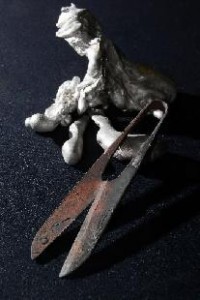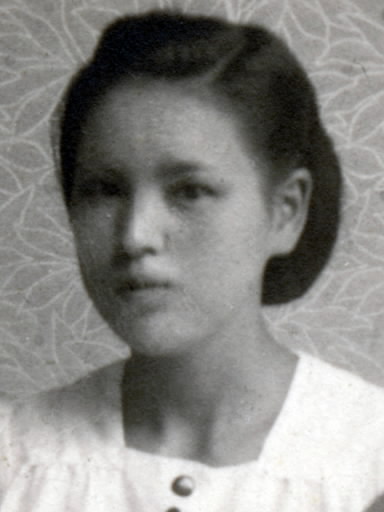Hiroshima: 70 Years After the A-bombing: Relics of the A-bombing 2
Jul. 3, 2014
Wife’s scissors
Digging through tears and sweat
“They were now all charred corpses, laying on the ground under the August sun.” This is an excerpt from an account of the A-bombing by Shunzo Ogawa, one of 165 such accounts that were solicited by the city for the first time in 1950. Mr. Ogawa wrote a detailed 11-page description of the devastation he saw when he came to Hiroshima on the day of the atomic bombing to look for his new wife, Itsue, then 21.
After their marriage the couple lived in Zaimoku-cho in Hiroshima (now part of Peace Memorial Park). At the time of the A-bombing, Shunzo was mobilized for work in Fuchu-cho at Toyo Kogyo (now Mazda), which had been requisitioned by the government.
“I found a shovel and began to dig through the smoking rubble,” Mr. Ogawa wrote. “With each jab into the embers, flames sprang up.” Two days after the destruction of the city he found Itsue’s nearly unrecognizable body at the site of their home. “My sweat and tears trickled down onto the hot bones and sizzled,” he wrote. He gathered up her thread scissors and an aluminum pot that had melted from the heat as well.
Shunzo later remarried and had two children.
His son, Hiroshima resident Kiyoshi, 62, a resident of Saeki Ward, said, “He never talked to us about his experiences. He kept his feelings locked up.” Kiyoshi didn’t learn of Shunzo’s written account until after his father died in 1996 at the age of 84.
But when he was a boy, his father took him and his sister to the Cenotaph for the A-bomb Victims every year on August 6 to pay their respects. He vividly recalls his father, who was usually a cheerful person, weeping along the way. In response to her husband’s grief, Kiyoshi’s late mother silently offered incense for Itsue at the family’s Buddhist altar.
Itsue’s family never recovered from their grief either. Her niece, Hiroshima resident Hiroko Yoneyama, 62, said, “For many years my mother and her siblings were rueful, knowing that my aunt would have been spared if they hadn’t allowed her to go back to Hiroshima.” Until the day before the atomic bombing, Itsue had been visiting her parents at their home in Yoshida-cho (now Akitakata-cho) for the first time since her marriage.
Upon learning about the scissors, Ms. Yoneyama said she was glad to know that there was evidence of her aunt’s existence. In January she visited the Ogawa family grave, where Itsue’s remains are interred, with Kiyoshi and his sister.
(Originally published on February 3, 2014)









